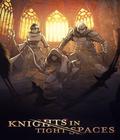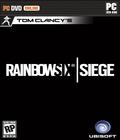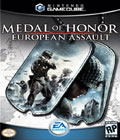Genre: FPS
Publisher: Electronic Arts
Developer: Electronic Arts
Release Date: June 6, 2005
Buy 'MEDAL OF HONOR: European Assault':
Xbox | GameCube | PlayStation 2
War Is Hell...ish.
How should it feel to snipe a Nazi? Satisfying, sure, for when you're an army of one, justice is a lead slug. And dramatic. Every enemy soldier you permanently discharge is a step toward victory, and most importantly, sniping, machine-gunning and Bazooka-ing Nazi troops should feel like a good time.
With Medal of Honor: European Assault, Electronic Arts drops its latest application of this formula onto the Nintendo GameCube. Considering the series' history on consoles, you might judge 2002's Frontline to be a triumph of shock and awe, and its sequel, Rising Sun, an undignified retreat. MoH: EA lands in the pyrrhic victory range of that scale, largely delivering on the good-time, first-person warfighting, but sacrificing some of the traditional MoH realism and drama.
Chaos Rules the Battlefield
True, but it takes its time reporting for duty. Your job, as Army Lieutenant William Holt, is to kill enough Nazis to settle things down and complete objectives assigned by the Office of Strategic Services (OSS). You'll be busy with tasks like planting explosives on artillery guns and blasting tracks to stop German supply trains - all familiar work to WW II shooter fans. You'll also command a three-person squad, alternately useful and in the way, through most of the game.
Coming off your first few assignments in St. Nazaire, France, you may feel you've taken a cake job. Even after you complete the four French missions and press into North Africa with the Desert Rats, victory still comes easy on the normal difficulty setting, and OSS jobs feel like errands. Why does the OSS need you to single-handedly destroy those Panzers? What are all those other soldiers doing anyway?
The Germans get around to really bringing it when you take the fight to the Soviet front. Tactical planning before you step out from behind the rubble becomes essential if you're going to stay alive to reach the next objective. Persistent machine gun fire streams over snowy hills, and enemy soldiers multiply across the landscape. You find yourself on the defensive more than once as they get more aggressive about attacking Allied strongholds.
Finally, seven missions in and more than halfway through the game, MoH: EA delivers some harrowing gameplay that lives up to the promise of Frontline's beach landing. It only gets better when you take off to the Battle of the Bulge for Holt's last set of missions.
Squeeze, Don't Pull
The controls that put you in Lieutenant Holt's boots make the most of current FPS conventions to be as recruit-friendly as possible, but with a few frustrations and curiosities. Looking and moving, as usual, are split between the right and left sticks. Grenade throwing, often a guessing game in your typical shooter, is more of a precision affair in MoH: EA, making it easy to lob grenades at bunkers and under tanks.
When you pull the left trigger to enter aim mode, your perspective zooms in slightly on your target, but you can't move. If you're crouching or crawling, aim mode lets you peek over and around obstacles, a useful skill, as most firefights are best fought from behind wrecked walls, stone fences, scorched craters and other hide-saving cover. The A button carries a heavy, context-sensitive load. It picks up weapons, sets timed charges, reloads and heals your squad, but if you're careful, it works out well enough in most situations.
The serviceable enemy AI occasionally pulls off a move like tossing a grenade back at you if you don't cook it first to time the explosion just so. It's not uncommon, however, for German soldiers to line up nice and tidy for you in front of a mounted gun, or jump behind the same no-good cover that failed to protect a few of their Nazi brothers from your sniping only seconds before. Still, for the most part, when the action kicks in, it pays not to underestimate the enemy's skills, or your own slaughterability.
Your squad is another story. You have two commands, position and recall, which they obey seemingly at their whim. They do take fire for you if you position them in battlefield hotspots, but they're just as useful simply running around nearby and shooting at will.
They're an awfully nervous bunch, too. Even when they're half dead, they rarely stand still long enough for you to get a bead on them and heal their wounds with your medkits. So, is your squad dumb? Not exactly. They're just undisciplined in a way that may be frustrating if you approach MoH: EA hoping for anything like a Rainbow Six-style command experience.
A couple of gameplay elements improve on MoH: EA's predecessors. Broader battlefields address the oft-repeated complaint that earlier single-player campaigns funneled you through such tight environments that they felt like they were on rails. The objective system complements the less-restricted levels by revealing secondary goals, like killing Nemesis characters (MoH: EA's version of high-value targets) and recovering intelligence documents, only when you explore thoroughly.
Completing secondary objectives rewards you with so-called revives that bring you back to life if you exhaust your medkits or just forget to use them in the heat of battle. Doing everything the OSS demands is also the only way to earn gold medals and the extra supplies that come with them. Other medkits are scattered in buildings, under bridges and in other unlikely places. So even if you're not a terribly patient soldier, it's worth your while to poke around a little.
Multiplayer offers 15 maps across which you can play split-screen death-match and goal-based Axis vs. Allies or Free for All rounds. Goals are mostly some variation on capture the flag and king of hill. The soldier class you choose pre-match - heavy weapons, sniper, infantry, or rifleman - determines your starting weapons, though you can change classes at highlighted points on the map. The customizable multi-round matches, with unique maps and objectives for each round, help vary the action in what is otherwise an eminently playable but familiar multiplayer experience.
Dulce et Decorum Est, For Real
When presentation and story work together, the drama's in full force, and you feel the significance of your actions. As the HMS Campbeltown rams the dock at St. Nazaire, you know you're in for something, even if the rest of the French missions do disappoint. The between-mission film reels and voiceover do a decent job of grounding the drama of the game in real-world history.
Moments of visual splendor surprise you from time to time. Climbing out of a dark bunker into the desert sun blinds appropriately, and for all you poet-soldiers, dawn over St. Nazaire doses you with enough beauty to keep you following orders without asking questions. Some cut scenes glow too much like a paper lantern, especially the Tunisia setup scene. While not unpleasant to look at, a more glaring and harsh visual treatment would play more effectively alongside the effect of peril the gameplay tries to achieve.
Don't expect much in the way of expressive faces, though, unless muddy patches of dried blood count as expression. Grenade blasts kick up dust and throw bodies into the air, but larger explosions don't erupt with enough fire and smoke to match the trouble you go through to make them happen. A few smaller fire effects in the desert look almost construction-paper flat, but do watch out for some animation details that liven things up, like helmets popping off when you score headshots.
Martial sentimentality dominates a score that's instantly recognizable to anyone who's seen any war movie ever, but it does its thing without distracting you from the action. In later missions, when your commanders feel the need to remind you what's at stake, radio chatter gets more frantic, and your comrades in arms are always shouting patriotic encouragement. Again, when you nail a headshot, listen for the solid plunk of lead busting the helmet.
Less Stripes, More Thin Red Line
All is not duty and honor in MoH: EA, however, as subtlety becomes the first casualty. Prepare early to be jolted out of your war when gameplay, presentation and graphic touches work against each other to push drama uncomfortably close to dramedy. Goofy icons representing ammo, health and weapons light up all over the battlefield. Worse still, green stars float over your squad members' heads, gradually turning red as they lose health.
The writing and voice acting sometimes test the limits of seriousness. The Soviets, particularly outburst-prone in MoH: EA, end fiery pre-battle pep talks with "For Stalin!" and loudly proclaim the glory of Mother Russia. Such excessive emoting seems out of step for a series that usually takes a fairly respectful point of view on its historical subject matter.
The prime offender here is the adrenaline meter. Call it bullet time, call it focus, call it a practical byproduct of the sands of time. Whatever you name it, giving Holt the ability to build up adrenaline and let loose a burst of invincible fury turns a war story into the tale of a super hero. It's handy, but feels like cheating, and it's every bit as authentic as handing him a spell book.
Back to Boot Camp
Why shouldn't a competent OSS agent be expected to recognize his friends and know how to find useful items on the battlefield without billboards advertising their locations? Shouldn't he be able to secure a bunker without the assistance of superhuman speed and constitution? Isn't that what basic training's for, to teach him how to keep his eyes open and not shoot his own squad?
Friendly fire isn't even an issue in the single-player campaign, and therein lies the problem. In grasping for accessibility, MoH: EA undermines the series' basic dramatic premise that you're an exceptional soldier, but still just a guy with some guns who's playing a tide-turning role in the events of World War II. If you're in it purely for the fun of soldiering, MoH: EA is a reasonable purchase title (although if you're a clock watcher, be warned that it falls a bit short of epic at around 10 hours). If you need the drama to complete your experience, the bright green medkits might taint the cinematic sweep, but it's perhaps worth a rental if you're a fan of the series or the genre.
Score: 7.1/10
More articles about Medal of Honor European Assault












 Europe 1942. These are desperate hours for Allied forces as the Nazi war machine rages across a devastated European landscape. You are US Army Lieutenant William Holt, hand-picked by William Wild Bill Donovan to be the first field agent of the newly formed Office of Strategic Servicesthe OSS. Medal of Honor European Assault makes you the driving force in the struggle to liberate Europe.
Europe 1942. These are desperate hours for Allied forces as the Nazi war machine rages across a devastated European landscape. You are US Army Lieutenant William Holt, hand-picked by William Wild Bill Donovan to be the first field agent of the newly formed Office of Strategic Servicesthe OSS. Medal of Honor European Assault makes you the driving force in the struggle to liberate Europe.























